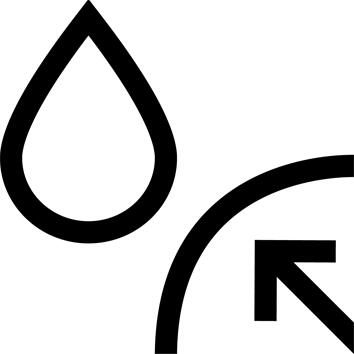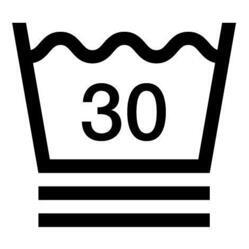Developed and validated by ocean racing skippers
The Tribord Offshore 900 kits have been developed and tested with sailors during a transatlantic race and single-handed offshore races on various boats: Jean-Baptiste DARAMY in the Class 40, Achille NEBOUT in the Figaro 3, Romain LE GALL and Léo BOTHOREL in the Mini 6.50.
How waterproof is the fabric?
The fabric is constructed with a 3-layer membrane, resistant to a water pressure of 30,000 mm Schmerber (JIS standard). The higher the pressure, the more waterproof the fabric.
The product has been tested under a storm rain simulator, reproducing a rainfall of 450 L/M²/h for 24 hours (3x8 hours).
Waterproof jacket
- Neoprene sleeves limit water ingress.
- The neoprene waistband is adjustable with 2-zone tightening to prevent water ingress between jacket and overalls.
- Seams are 100% taped.
- A rigid visor is integrated for added protection.
What is water repellency and how do I maintain it?
Fabrics and fastenings are water-repellent.
The water repellency of a fabric is its ability to let water slide off its surface without absorbing it.
This means your jacket won't become waterlogged, remaining light and breathable. Water repellency is achieved by a treatment (DWR) applied to the outer face of the fabric, but these properties can be altered with use.
Water repellency can be reactivated by tumbling the jacket for 10 minutes at low temperature.
Breathability
To determine whether a fabric is breathable, we measure its evaporative resistance, known as RET (test based on ISO 11092 standard). This is the fabric's capacity to let the water vapor produced by the body during exercise escape to the outside.
To determine whether a fabric is breathable, we measure its RET evaporative resistance (ISO 11092 standard). The lower the resistance, the more water vapor escapes from the fabric, making it more breathable.
The RET of this product is 25.
Removable hood and double collar
The collar is made up of 2 parts:
- A neoprene part with a zip and Velcro to facilitate adjustment and prevent water from entering the collar. This collar ends in the middle of the neck.
- A "storm" part, with the hood and collar up to the nose for optimum protection. This part is removable with a zipper around the neck. The inside of the collar is lined with a soft micro-fleece component for added comfort.
- The collar closes with Velcro.
Hood adjustment and storage
- The hood is stored in the collar of the jacket.
- The hood has 2 adjustments: one at the front to adjust it to your face and prevent it from coming off in the wind, and the other on the head to adjust the depth of the hood.
- A rigid visor is integrated for added protection.
Double sleeve
- A part with a neoprene sleeve against the skin to prevent untimely water ingress.
- A waterproof fabric sleeve, adjustable with a Velcro fastener to protect the neoprene and offer maximum waterproofness
Tip: if you wear mittens or gloves, insert them between the 2 sleeves for greater comfort and to prevent water ingress by capilarity.
Pockets
The jacket has 2 large pockets:
- a compartmentalized, waterproof storm pocket, easily opened through the flap. Inside the storm pocket, a waterproof pocket held by an elastic tie with a removable hook for storing your phone
- 1 non-waterproof communicating hand pocket, with fleece lining on the outside.
The pockets are equipped with a drainage system to allow water to drain away.
Abrasion resistance
The jacket features reinforced elbows and forearms for optimum abrasion resistance.
Weight
The jacket weighs in size L:
- 1020 grams with collar
- 760 grams without collar
How to choose your jacket size?
The product is loose-fitting. It is designed to be worn with thermal underwear and a fleece underneath.
For men, choose your usual size.
For women, choose a size smaller than your usual size.
How to care for your jacket
After use, rinse the jacket thoroughly with clean water, not forgetting the zippers to remove the salt.
Dry on a hanger in a well-ventilated area.
We recommend drying your jacket completely in the open air, flat on a drying rack. Never dry your jacket directly on a radiator.
The loop in the back allows you to hang your jacket on a hook or coat rack to dry it if you can't lay it flat.
How to wash your jacket Step 1
Close all zips and flaps. Also remember to loosen straps and elastic parts (hood) and empty pockets.
Then turn garment inside out to wash inside out.
How to wash your jacket Step 2
You can wash your jacket in a 30° synthetic program with your usual detergent. Do not use fabric softener, which could damage the garment's original performance, or bleach.
Also take care not to fold your jacket too much when you place it in the washing machine, and to limit the load.
Very important: select a thorough rinse or double rinse to remove all detergent residues.
How to reactivate water repellency?
Drying is essential to reactivate the water-repellent treatment.
We recommend that you let your jacket dry completely in the open air, flat on a drying rack. Never dry your jacket directly on a radiator or in direct sunlight.
Then tumble-dry on the synthetic program for a short time (10 to 15 minutes) before putting it back on. Be careful not to over-dry the garment.
How do you dry or hang your jacket?
A webbing loop lets you hang your jacket on a hook or coat rack for drying.
What's the difference between a vareuse and a veste de quart?
The jacket is ideal for maneuvering at the front of the boat (positions 1 and 2), and its half-zip provides extra protection in extreme conditions.
On the other hand, the jacket is more suitable for less exposed positions, and its zipper makes full opening quick and easy.
























